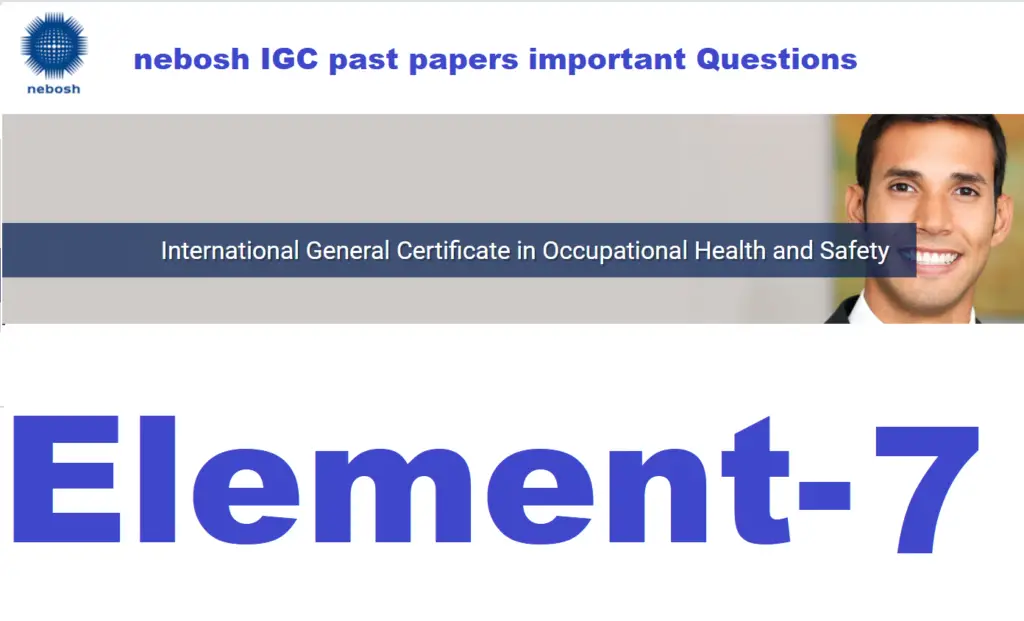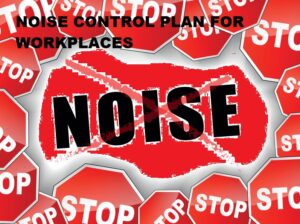nebosh IGC element 7 important question answers

Element 7
7.1 Outline the forms of, the classification of, and health risks from exposure to hazardous substances.
- Identify the different forms of biological agents. (3)
- Identify the different classifications of chemicals. (6)
- Give the meaning of acute and chronic effects. (4)
- Identify the different forms in which chemicals and hazardous substances are present in workplaces. (6)
7.2 Assessment of the health risks
- Identify the different routes of entry of chemicals into the human body. (4)
- Identify the different respiratory defenses. (6)
- Identify the skin defenses. (3)
- Identify the cellular defenses. (6)
- Outline the factors to be considered for the assessment of hazardous substances
exposure. (8) - Identify the information that are available in a material safety data sheet. (8)
7.3 Occupational exposure limits
- Give the meaning of Occupational Exposure Limit. (2)
- Identify the types of OEL. (2)
- Outline the limitations of OEL. (4)
- (a) Give the meaning of the term ‘respirable dust’. (2)
Answer:
(a) Respirable dust is any type of dust that has the capacity to enter into the respiratory system through inhalation (< 7 microns).
(b) Following methods can be used for monitoring airborne dust levels in the workplace:
- Stain tube detectors: they use direct reading glass indicator tubes filled with chemical crystals which change color when a particular hazardous substance passes through them.
- Passive sampling: the worker will be wearing a badge type sampler containing absorbent material. Tube type samplers are also available. Sample is taken for a full working period, and sent to the laboratory for analysis.
- Sampling pumps and head: used to measure gases and dusts. The worker wears a collection head and pump, sample is collected and sent for analysis.
- Direct reading instruments: e.g. infrared gas analyzers.
- Smoke tubes can be used for indicating the direction of flow of air.
- Dust lamp: used to observe dust particles by using a light beam.
- Identify TWO classifications of hazardous substances where exposure must be reduced to as low as reasonably practicable below the WEL. (2)
7.4 Control measures
- Outline control measures required in order to minimize risks to workers from toxic chemicals. (8)
- Identify the factors that will reduce the effectiveness of a local exhaust ventilation. (8)
- Identify the factors to be considered while selecting an RPE. (8)
- a) Identify FOUR examples of workplace situations in which a breathing apparatus has to be used. (4)
b) Identify any four measures that might reduce the effectiveness of the use of a breathing apparatus. (4) - Outline personal hygiene controls to reduce the risk of ingestion of a hazardous
substance. (6) - An organization is using small quantities of a toxic chemicals.
(a)Explain the difference between acute and chronic health effects. (6)
(b) Identify the sources of information which could be used in the assessment of
risk of toxic substances . (6)
(c) Outline the control measures that might be required in order to minimize risks to workers from exposure to toxic chemicals. (8) - Large sheets of wood are cut to size in a workshop using a powered mechanical saw. The cut sheets are then joined together using a solvent based adhesive.
(a) Outline factors to consider when undertaking an assessment of the health risks associated with exposure to wood dust and the adhesive. (4)
(b) Outline control measures that could be taken to reduce risks to the health of workers from exposure to wood dust and the adhesive. (4)
Ans:
a) While undertaking the assessment of health risks, the following factors should be considered:
Hazardous nature of the materials and their potential ill health effects, their possible routes of entry to the body and any relevant exposure limits. Consideration should also be given to factors such as the quantity of solvents used and level of duct produced from wood cutting activity, the likely duration and frequency of exposure to solvents, the number and types of persons who would be exposed and the effectiveness of the existing control measures.
b) Control measures to reduce risk from exposure to wood dust and chemical adhesive would be – to check the possibility of avoiding the solvent based adhesive or substituting; segregating the processes such as by cutting the wood and applying the adhesive in booths fitted with local exhaust ventilation; reducing the frequency and duration of exposure by the use of job rotation and providing respiratory and other personal protective equipment to workers such as hand gloves, face shield, safety goggles etc.
7.5 Hazards, risks and controls associated with specific agents.
- Identify the health effects of exposure to:
(a) Asbestos (4)
(b) Silica (4) - Outline the measures to be taken by the employer to reduce risk from asbestos in the workplace. (8)
- (a) Identify FOUR possible ill health effects that can be caused from working with cement. (4)
- Identify the ill-health effects caused by
(a) Legionella bacteria. (2)
(b) Leptospira bacteria (2) - Identify the workplace circumstances where Leptospira bacteria may be present. (2)
- Outline the control measures to reduce risk from:
(a) Legionella bacteria (4)
(b) Leptospira bacteria (4)
7.6 Safe handling and storage of waste.
- Outline the issues that need to be considered during handling, storage and final disposal of hazardous waste materials. (8)








